

We love rock climbing shoes, and we bet you do, too. We've been testing these sticky kicks for over eight years—on terrain ranging from sharp limestone spires in Mexico to lofty cliffs in Nepal—to hone in on our selection. Whether you’re looking for an aggressively downturned shoe for hooking your way up boulder problems, or a comfortable design for all-day granite ascents, we’ve got you covered. Below we break down the 18 best rock climbing shoes of 2025. For more information, see our comparison table and buying advice below the picks, along with details about our testing process. And if you’re just getting into the sport, check out our list of the best rock climbing shoes for beginners.
Editor's note: We updated this guide on July 7, 2025, to include several photos from recent testing trips. We also swept the guide to ensure all other information was current at the time of publishing.
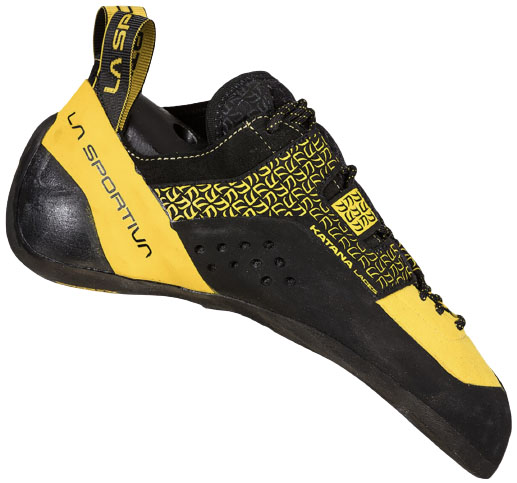 Best uses: Sport, trad, gym
Best uses: Sport, trad, gym
Downturn: Moderate
Upper: Leather
What we like: Versatile yet high-performance; available in two versions.
What we don’t: Expensive; most boulderers will want a softer shoe.
Of all the shoes in our quiver, the Katana Lace is the one we reach for most, whether we’re sport climbing at Smith Rock, multi-pitch climbing in Red Rock Canyon, or ascending finger cracks in Indian Creek. What stands out most about the Katana is its ability to do almost everything well: crack climbing, smearing, technical face, slab, pockets—you name it. Sized up and worn in, you get a comfortable all-day shoe with much more precision than a flat design like the TC Pro, and a liner at both the heel and toe boosts comfort and breathability, too. Worn tightly, the Katana’s edging prowess is on par with the likes of the Otaki. And unlike many sport climbing and bouldering shoes, the Katana’s moderate downturn and wide toe box are a great match for wide feet or climbers who aren’t sold on a more aggressive design.
The Katana Lace was updated in 2023, with the biggest news being the release of two models: a yellow version (labeled as “men’s”) and a white version (labeled as “women’s”). The yellow Katana is similar to the outgoing design, featuring a full last and stiff yet sticky Vibram XS Edge rubber that work together to provide a powerful edging platform. On the other hand, the white version is built with a split last and softer XS Grip 2 rubber, resulting in a more sensitive and flexible feel. While these are designated by gender, the primary difference lies in the type of rubber used, so either men or women could benefit from both models depending on their preferences and climbing goals.
See the Men's La Sportiva Katana Lace See the Women's La Sportiva Katana Lace

 Best use: Beginner
Best use: Beginner
Downturn: Flat
Upper: Leather
What we like: A durable and comfortable shoe at a great price.
What we don't: Not a high-performance design.
Whether you’re a new climber or just looking for an inexpensive shoe to thrash in the gym, it doesn’t get any better than the La Sportiva Tarantulace. Our favorite thing about this shoe is price: In an era when climbing shoes have risen to over $200, the Tarantulace has kept costs low. It still checks all the boxes for most casual climbers, with an unlined leather upper that will conform to your feet over time, a flat last and roomy toe box for excellent comfort, and a sticky yet durable FriXion RS rubber sole. In short, it’s for good reason that we see the Tarantulace at the gym and the crag more than almost any other shoe.
Most beginner climbers won’t be too picky about their climbing shoes, prioritizing factors like durability and comfort over performance. That said, if you’re a quick learner, a strong athlete, or primarily interested in bouldering, it might be worth starting with a more purpose-built design. In our experience, we’ve found the Tarantulace to be fairly stiff and insensitive—along with its roomy build, this makes it a great shoe for all-day comfort (think moderate multi-pitch routes or long gym sessions) but not ideal for steep or technical climbing. It’s worth noting that La Sportiva now makes the gym- and bouldering-oriented Tarantula Boulder ($119), which features a softer build and higher-performance toe and heel for better hooking capabilities, along with a standard Velcro Tarantula ($99). And for a more comprehensive list of entry-level options, check out our article on the best climbing shoes for beginners.
See the Men's La Sportiva Tarantulace See the Women's La Sportiva Tarantulace
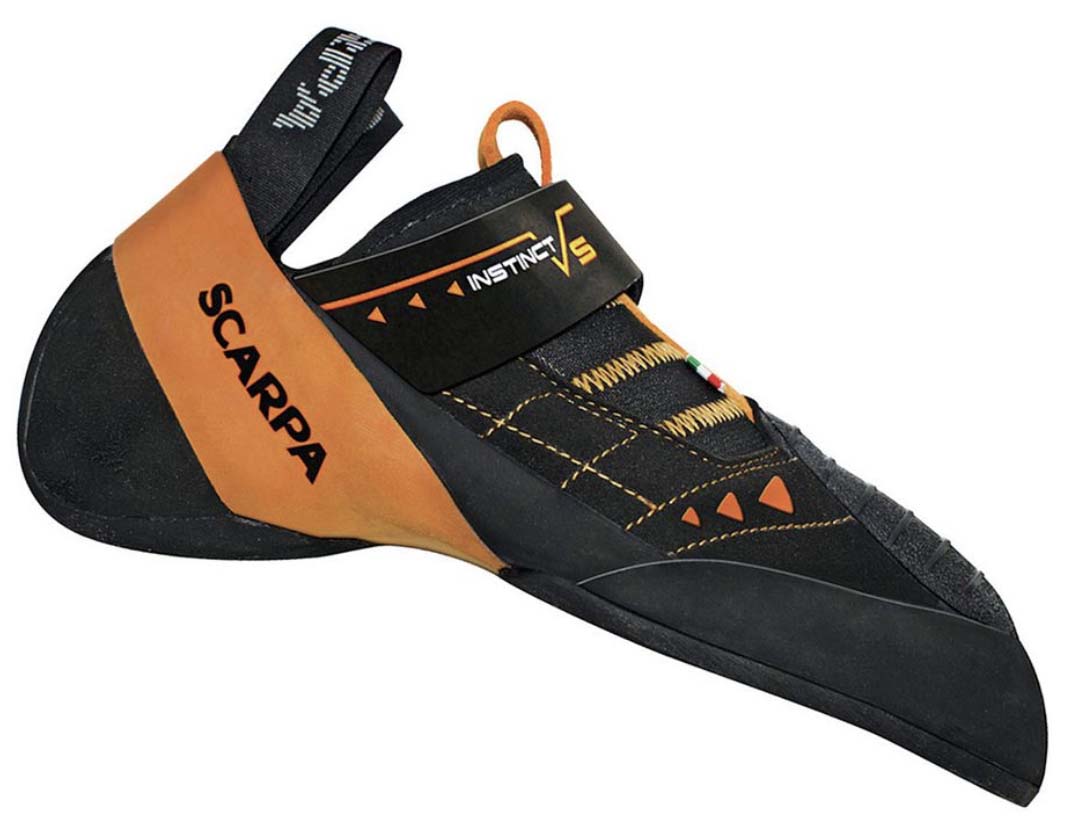 Best uses: Bouldering, sport, gym
Best uses: Bouldering, sport, gym
Downturn: Moderate
Upper: Synthetic
What we like: A bouldering slipper that provides amazing support.
What we don’t: Some will want a softer shoe.
The Instinct VS is a newer shoe from Scarpa that has quickly grown in popularity since its release. It established itself as a versatile choice for sport climbing and bouldering, but it’s also a common pick for indoor and competition climbing. Notably, 11-time American Bouldering Series champion Alex Puccio cites the Instinct VS as her favorite shoe. The rubber-shrouded toe and heel are excellent on steep rock, and the medium-stiff rand offers more edging power than we’re used to seeing in a bouldering shoe.
Made with synthetic microsuede, the Scarpa will stretch less than a leather shoe, but an elastic patch on the top of the foot gives it a close fit. The stiff feel and moderate downturn set it apart from most shoes made for high-performance sport climbing and bouldering, but a thinner 3.5mm sole adds sensitivity and flex (note that the XS Edge rubber on the men’s version is replaced with XS Grip 2 on the women’s model for an even softer, grippier shoe). Scarpa also offers the same design in a softer version with a 2mm sole (the VSR), which is ideal for lighter climbers or those who prefer a more sensitive feel. And the impressive Instinct family is rounded out by a high-performance lace model and a slipper (S), each of which are quality, standout shoes in their own right.
Read more: Scarpa Instinct VS review
See the Men's Scarpa Instinct VS See the Women's Scarpa Instinct VS

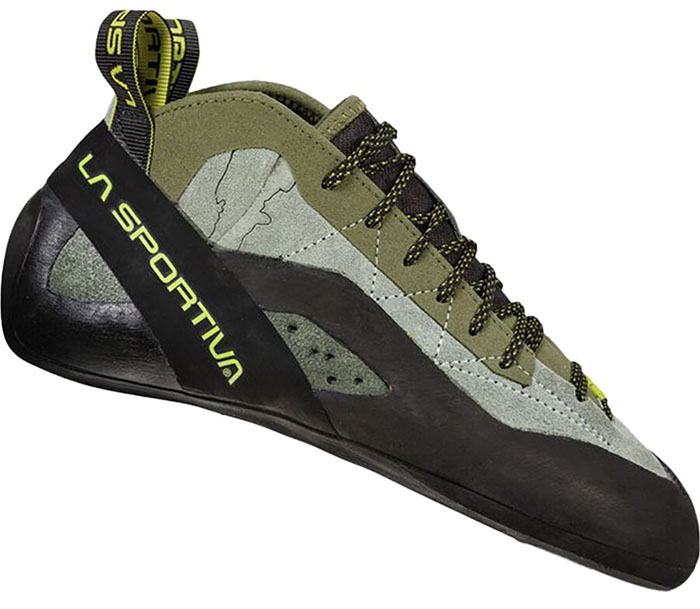 Best use: Trad
Best use: Trad
Downturn: Flat
Upper: Leather
What we like: The best granite and crack climbing shoe on the market, hands down.
What we don't: Expensive and very specific.
If you’re reading this, there’s a good chance you know who Tommy Caldwell is. He climbed this little thing called the Dawn Wall in Yosemite in 2015, and this is the shoe that he designed for the job. As a result, the TC Pro is an absolute climbing machine for vertical to less-than-vertical terrain—and specifically granite. While we often correlate a flat shoe with a beginner shoe, this is a notable exception: The stiff makeup and sticky XS Edge rubber make it an ultra-high-performance edger and slabber. But why most climbers love the TC Pro is its stellar performance in cracks. With padding at the tongue and ankles and a mid-height upper, it provides game-changing protection for everything from thin foot jams to burly offwidths. One of our editors has scaled El Cap multiple times in TC Pros, where they've felt perfectly at home on the endless splitters and thin granite edges. We don't just don these in Yosemite, though—our editor in the southeast can frequently be seen lacing them up for delicate sandstone face climbs or trad crack lines from Chattanooga to the Red River Gorge.
La Sportiva semi-recently revised the TC Pro—the first update since the shoe’s debut in 2008. Without impacting the overall feel of the shoe, La Sportiva attended to the first iteration’s weaknesses, including the rolling tongue, rand delamination, and durability around the laces. The lacing harness is now constructed with microfiber reinforcements, which increase abrasion resistance while jamming the shoe into cracks. We’ve found the sizing to be similar, although the break-in period is fairly intense given the stiff build. All told, just like the outgoing model, the second-gen TC Pro is a do-all shoe for everything from 5.14 granite test pieces to moderate multi-pitch routes, providing the support, protection, and durability that trad climbers need. Boulderers, gym climbers, and most sport climbers—look elsewhere.
Read more: La Sportiva TC Pro review
See the La Sportiva TC Pro

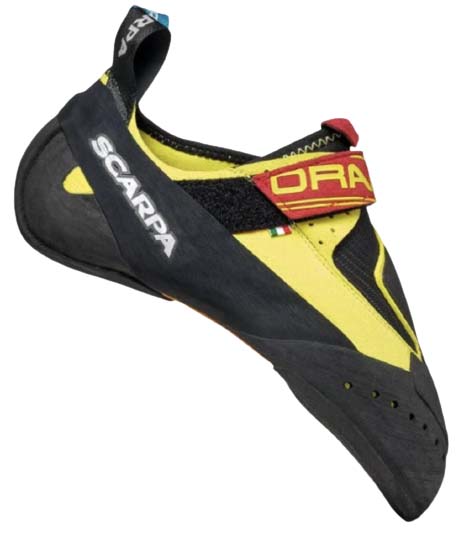 Best use: Gym, bouldering, sport
Best use: Gym, bouldering, sport
Downturn: Aggressive
Upper: Leather/synthetic
What we like: A purpose-built comp shoe at a good value; comes in regular and low-volume versions.
What we don’t: Lacking in versatility.
As gym and competition climbing booms and setters get more creative with volumes, slabs, and the odd circus trick, there’s a growing demand for purpose-built shoes. High-performance gym climbing designs are characterized by ultra-soft builds (including little to no midsole), soft and sticky rubber, and a rounded toe for better smearing performance on volumes. Within this category, the Scarpa Drago has risen to the top thanks to its fantastic fit and build quality, generous rubber patches, and decent edging abilities despite its soft makeup. The Drago also comes in standard and low-volume (LV) sizes, so chances are high you can find a good fit (you’ll want to size your comp shoe fairly tight).
Most brands offer a variety of sensitive, indoor-specific shoes—a fairly logical progression following the boom of climbing gyms and climbing’s Olympic debut—so there’s no shortage of competition for the Drago. La Sportiva has their Solution Comp (a more supple version of the Solution below), and they’ve also added the Theory, an even softer shoe with No-Edge technology. Within Butora’s lineup, the Acro Comp and Gomi are intriguing choices. And if you’re just starting out, check out Scarpa’s Veloce below, one of our editor's favorite picks as a lightweight, super-sensitive shoe at a budget price. Of course, some climbers will just opt for an old pair of beaters or cheap used shoes for gym sessions, which is undeniably the most economical way to go. But if you’re serious about indoor climbing, you’ll benefit a lot from a soft, sensitive, and sticky design like the Drago.
See the Scarpa Drago See the Scarpa Drago LV
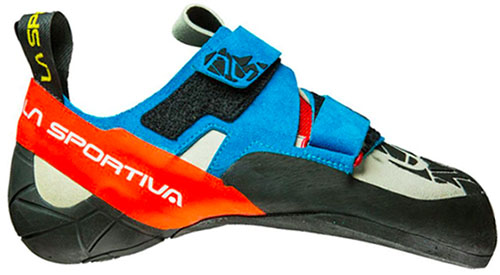 Best uses: Sport, trad
Best uses: Sport, trad
Downturn: Moderate
Upper: Leather/synthetic
What we like: A versatile, comfortable shoe that’s especially great for technical edging.
What we don’t: Not ideal for crack climbing; some will find the wide toe box too sloppy.
The Otaki is a relatively recent innovation from La Sportiva, combining an approachable fit with a high level of performance for both sport and trad climbing. We’ve worn this shoe on everything from vertical dime edges and steep, pocketed limestone to hard finger cracks (it was our shoe of choice for free climbing Moonlight Buttress) and have been super impressed with its performance. In many ways, it’s a Velcro alternative to the Katana Lace above, but with a more aggressive downturn and S-Heel technology that provides some extra oomph on steep terrain. We’ll note that because of the Velcro closure and more downturned shape, the Otaki is not a great fit for most crack climbs.
We used to rank Sportiva’s classic Miura VS high on this list, but the Otaki has become the more popular choice thanks to its approachable fit (the Miura VS has a unique toe box that won't work for everyone). Its snug heel cup is great for those with low-volume feet, and the wide toe box adds comfort and versatility for a range of foot shapes. And unlike the Katana, the Otaki’s heel cup is unlined, which results in a less plush and breathable feel but a lot more precision—especially for heel hooking. By this point, it’s hopefully becoming clear how to prioritize the two shoes: The Katana is still our pick for all-day performance and crack climbing, but the Otaki offers a slight level up for steeper or more challenging terrain. And because it’s a shoe that you’ll likely want to remove between pitches (even on a multi-pitch), the convenient two-strap Velcro closure makes a lot of sense.
See the Men's La Sportiva Otaki See the Women's La Sportiva Otaki
 Best uses: Trad, sport, beginner
Best uses: Trad, sport, beginner
Downturn: Moderate
Upper: Leather/synthetic
What we like: A comfortable quiver-of-one shoe for intermediate climbers.
What we don’t: Not great for bouldering.
The Scarpa Vapor V is a textbook all-rounder, designed to balance both comfort and performance on a variety of terrain. Whether you’re looking for a step up from your beginner shoes or are on the hunt for a versatile design that can handle the variability of multi-pitch climbing, the Vapor V could be your answer. Similar to the La Sportiva Katana Lace above, the Scarpa features a moderately downturned last, soft microsuede upper and mesh-gusseted tongue, and an edging platform that excels on techy, vertical rock. The wide toe box keeps comfort high, and you can play with size depending on your goals: A relatively loose fit is great for all-day wear on multi-pitch routes (and better on slabs and cracks), while we prefer a tighter feel for redpoint burns at the sport crag.
All that said, the Scarpa Vapor V isn’t for everyone. First, with only 3.5 millimeters of XS Edge rubber, this shoe is known for wearing out quicker than most (for comparison, the yellow Katana has 4mm). Second, not everyone will love the Velcro closure—we typically prefer a lace-up shoe when we expect to encounter cracks on a multi-pitch climb. And finally, while the Vapor V balances conflicting priorities better than most, it doesn’t cross over very well for steep climbing or bouldering. All in all, for a shoe that can handle most disciplines while still being comfortable, Scarpa’s best-selling Vapor V is worth having on your radar.
See the Men's Scarpa Vapor V See the Women's Scarpa Vapor V
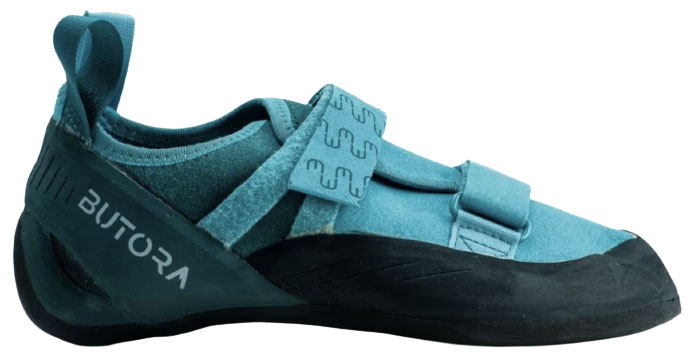 Best uses: Beginner, gym, trad
Best uses: Beginner, gym, trad
Downturn: Flat
Upper: Synthetic
What we like: A great combination of price, performance, and comfort.
What we don't: Not ideal for steep terrain or cracks.
Butora might not be as big of a name as Scarpa or La Sportiva, but the Korean-born company has established itself as an important player in the U.S. climbing shoe market. Before launching the brand in 2014, shoe designer Nam Hee Do was in the business for over 30 years. Most notably, he worked with Chris Sharma to design the Evolv Shaman below, so it comes as no surprise that Butora’s shoes display impressive attention to detail and utilize top-notch materials. The Endeavor is their popular workhorse model: With a durable synthetic upper, slight downturn, ABS midsole for edging power, and sticky Neo Fuse rubber, the shoe delivers performance for beginner-to-intermediate climbers or penny pinchers who don’t want to compromise on quality.
If you have a hard time finding shoes that fit, the Endeavor comes in half sizes from 34 to 49 and two widths. And compared to the more affordable La Sportiva Tarantula (the Velcro version of the Tarantulace above), it’s less brick-like and has a much stickier rubber sole. Butora uses Neo Fuse on its high-end models—great news for beginners quickly progressing to the next level. However, it is important to keep the Endeavor within its wheelhouse: With very minimal downturn, it’s not a great choice for gym and outdoor climbers who frequent overhanging terrain. We also don’t love Velcro shoes for crack climbing (they can cause painful pressure points and might come undone while jamming). But for slabby-to-vertical rock, the Endeavor strikes an excellent balance for those who prioritize price, performance, and comfort.
See the Butora Endeavor 2.0 (Wide) See the Butora Endeavor 2.0 (Narrow)
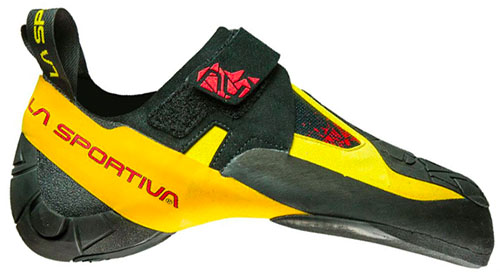 Best uses: Bouldering, sport, gym
Best uses: Bouldering, sport, gym
Downturn: Aggressive
Upper: Leather/synthetic
What we like: A sensitive, aggressive shoe that’s also very comfortable.
What we don’t: Too soft to be a great edger; lacks support for long, vertical pitches.
A La Sportiva innovation that quickly rose to popularity, the Skwama is a performance climbing slipper with a thin midsole and supple Vibram XS Grip 2 rubber. It moves as an extension of your foot and lets you feel every contour in the rock. What’s more, Sportiva’s P3 midsole means the shoe retains its downturn over time. The benefits of this construction come on steep terrain: The slipper provides incredible precision for heel and toe hooks, aided by the generous heel and toe rubber and a snug S-Heel design, and puts your foot in an aggressive position that allows it to perch on steep edges and nubs. The Skwama isn't a standout edger, but we love how precise you can be with its sensitive design, and it boasts a genuinely cozy fit—making it a bit more versatile than La Sportiva's own Solution below.
One of the highlights of the Skwama is its high degree of comfort, thanks to the roomy toe box, soft build, and fairly gentle downturn (it’s built on a PD 75 last). The most glaring downside of this soft construction is the lack of support underfoot, which makes the Skwama a poor choice for long pitches (especially when you’re standing on your feet) and does not inspire a ton of confidence on vertical edges. Those used to a stiffer shoe will find that their feet grow noticeably sore in the Skwama. But for steep sport climbing and bouldering—and the occasional vertical trad or sport pitch—it’s quickly become a go-to option for many. Finally, the Skwama is also made in a vegan design for the same price, which won’t stretch as much as the leather model but is a nice alternative for those looking to minimize their impact.
Read more: La Sportiva Skwama review
See the Men's La Sportiva Skwama See the Women's La Sportiva Skwama
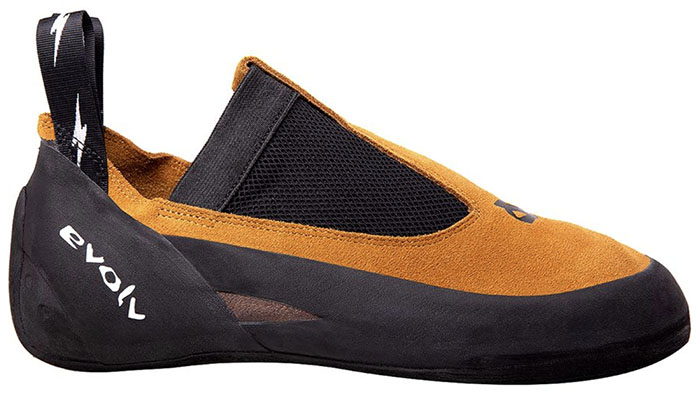 Best uses: Trad, gym
Best uses: Trad, gym
Downturn: Flat
Upper: Leather
What we like: A great all-around slipper that’s particularly good for thin cracks.
What we don’t: Unlined and you can’t customize the fit.
Most modern climbing slippers are designed for bolt-clipping and bouldering on steep terrain. They're super soft, relatively aggressive, and fit snugly with a Velcro closure near the ankle. But the Evolv Rave goes old-school with a fully slip-on construction, flat last, and all-rounder intentions. These are Steph Davis’ shoe of choice for Indian Creek splitters (they have a very narrow toe box, which is great for thin cracks). And at just $139, they’re also a solid option for those just starting out (whether outdoors or indoors). To top it off, the Rave is exceptionally comfortable, quick to get on and off, and will conform to your foot like a glove.
Compared to Five Ten’s popular Moccasym, Evolv’s slipper is stiffer (read: more support for long routes), and the snug heel offers a more secure fit overall. And you'll certainly notice the difference between the Rave's leather upper and the Moccasym's synthetic: Leather tends to provide a more secure fit, as the shoe conforms to your foot's contours over time. But not everyone is a fan of slippers—you can’t customize the fit like you can with a Velcro or lace closure, and some climbers (especially those just getting into crack climbing) will appreciate a bit more padding. But for the right user, the Rave is a comfortable, affordable, and versatile choice. And if you like the idea of a slipper but want something more aggressive, it’s worth checking out the Scarpa Instinct S or La Sportiva Mantra.
See the Evolv Rave
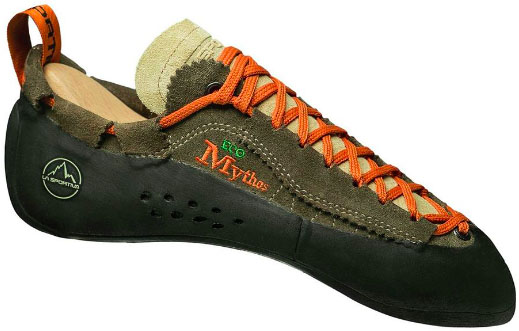 Best uses: Beginner, trad
Best uses: Beginner, trad
Downturn: Flat
Upper: Leather
What we like: A time-tested classic made with 95%-recycled materials.
What we don’t: At the end of the day, it's not very performance-oriented.
The Mythos is one of the most iconic shoes on the market. And for new climbers venturing outside, this is an incredibly comfortable and durable choice. It has a flat last and leather upper that allow it to be worn all day, and the quality Eco rubber on the sole means you get top-notch performance, too. For beginning climbers and intermediates alike, it’s a great choice.
While the Mythos is ideal for beginner climbers or those looking for all-day comfort, it's not a particularly versatile choice. It’s not made for cranking through long overhanging sport climbs, nor for heel- and toe-hooking your way through roofs. Even among the beginner shoes on the market, it isn’t the best option for smearing or edging. Heck, we don’t even recommend the Mythos for gym climbing—it’s overkill and expensive for what you need. But it’s certainly among the most durable and best-fitting of the bunch, making it a nice option for beginner trad climbers in particular. And it doesn’t hurt that the Mythos Eco is made using 95%-recycled materials from La Sportiva's cutting-room floor.
See the Men's La Sportiva Mythos Eco See the Women's La Sportiva Mythos Eco
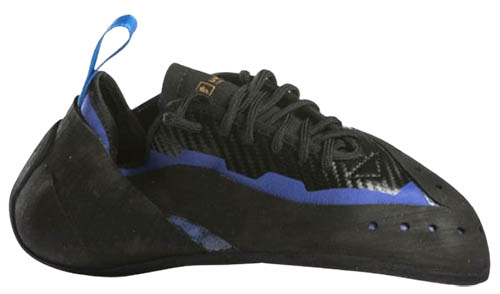 Best uses: Sport, bouldering
Best uses: Sport, bouldering
Downturn: Aggressive
Upper: Synthetic
What we like: More affordable than the competition and made in the U.S.
What we don’t: Difficult to find in stores.
If you haven’t yet heard of Unparallel, here’s an introduction: After Five Ten was bought out by Adidas in 2011, their production moved overseas, leaving their SoCal factories and many former employees idle. Before long, Unparallel was born, taking over Five Ten’s abandoned spaces with a resolve to carry the U.S.-made torch. Now, this grassroots company makes a full lineup of climbing, mountain biking, and commuter shoes, with a strong focus on high-quality materials and construction.
Unparallel’s Sirius Lace is one of their most popular shoes, rivaling other models here in terms of precision for vertical and overhanging terrain. The Sirius is a bit stiffer than La Sportiva’s popular lace-up, lending slightly more support and power on technical edges. And for better toe-hooking performance on steep routes and boulders, it also tacks on offset lacing and a rubber patch on the toe. That said, you do sacrifice other shoe's glove-like fit with a synthetic upper, and we’ve found it hard to track down these shoes to try on in person. All in all, Unparallel might not get the same recognition as brands like La Sportiva and Scarpa, but they’re a rising star, and it certainly doesn’t hurt that their shoes are typically priced a bit more affordably than the competition.
See the Unparallel Sirius Lace See the Unparallel Sirius Lace LV
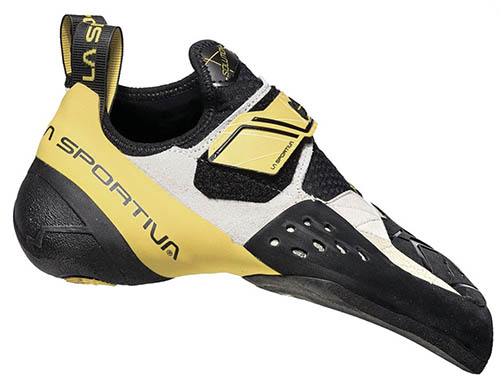 Best uses: Sport, bouldering, gym
Best uses: Sport, bouldering, gym
Downturn: Aggressive
Upper: Leather/synthetic
What we like: A classic shoe for sport climbing and bouldering.
What we don’t: It doesn’t quite measure up in an increasingly competitive field.
The Solution is an excellent shoe, hands down. It’s been the go-choice among some of the world’s best climbers for years now, performs equally well indoors and outdoors, and dominates steep boulders and sport climbs alike. It edges like a dream on tiny foot chips, features sticky and sensitive Vibram XS Grip 2 on both the women’s and men’s offerings, and boasts a hefty dose of heel and toe rubber for all sorts of performance on overhanging terrain. Climbers have long lauded the Solution’s pointy toe for pocketed limestone in particular, and like most of Sportiva’s downturned kicks, a P3 platform holds the shape of the shoe over time.
With all that praise, why is the Solution ranked so low on our list? In short, the climbing shoe competition has become fierce. Back in 2007 when the Solution was first released, it was a cutting-edge design and offered top performance for hard climbing. Now, aggressive and precision-oriented slippers are a dime a dozen. What’s more, the Solution isn’t exceptionally durable, and many find the heel cup to be ill-fitting and clunky. If you’re a Solution diehard, by all means, stay true to your shoe (or level up to the softer and snugger-fitting Solution Comp). But if you’re on the hunt for your first aggressive slipper for bouldering or sport climbing, we’d encourage you to look higher on this list.
See the Men's La Sportiva Solution See the Women's La Sportiva Solution
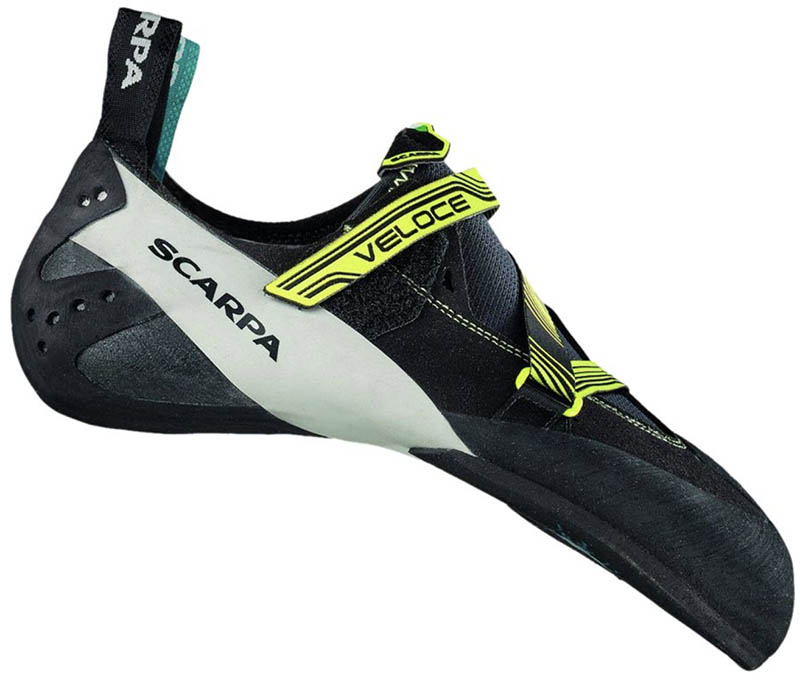 Best uses: Gym, beginner
Best uses: Gym, beginner
Downturn: Moderate
Upper: Synthetic
What we like: Better gym performance than most beginner models.
What we don't: Expensive for an entry-level shoe and sole; not particularly durable; heel slips easily.
In years past, beginners typically cut their teeth on low-angle slabs outside, where flat and stiff shoes like the Tarantulace and Mythos above shine. But with more and more climbers getting their first taste of the sport on indoor walls (read: steeper routes with bigger holds), there’s a new demand for softer and more downturned entry-level kicks. The Veloce is Scarpa’s answer, merging gym climbing sensitivity with a comfort-focused shape and decent price tag that undercuts much of the more aggressive competition. It's also one of the lighter shoes we've owned and has a "barely there," nimble feel with pretty stellar sensitivity.
As a new climber, you have a lot of options when it comes to shoes, including all-rounders like the Tarantulace and outdoor-specific models like the Mythos. But if you’re getting your start inside and don’t expect to venture outdoors for a while, the Veloce is an excellent choice. We do wish the shoe had slightly more durable rubber, as beginners with poor footwork will blow through the sticky S-72 outsole in very little time (remember, you can always get a resole). We also wish the heel cup were a bit tighter for better precision. But for beginners with good technique or intermediate climbers who have already learned their way around plastic holds, the Veloce is a great ‘tweener shoe that won’t hold you back as you progress.
See the Men's Scarpa Veloce See the Women's Scarpa Veloce
 Best uses: Sport, bouldering, gym
Best uses: Sport, bouldering, gym
Downturn: Aggressive
Upper: Synthetic
What we like: Stellar sensitivity and precision, tight but comfortable fit, and stiffer than other No-Edge models.
What we don’t: Can feel too flexible when heel-toe camming; on the squishy side for tiny edges.
We've been climbing in La Sportiva's Futura for years but could never quite find the sweet spot for the No-Edge technology—until now. In lieu of a sharp, 90-degree angle where the rand meets the sole as two separate panels, the design features a large toe-scumming patch that rounds over the forefoot. While great for toeing into shallow, incut holds like divots and dishes, our Futuras have struggled on outdoor routes where edging on sharp, variable rock is a must. However, the new Mandala is a breath of fresh air in this regard, with a stiffer feel and beefier toe than the Futura that result in better outdoor prowess while maintaining the sensitive feel we’ve come to love. The shoes still have that No-Edge “smush” that molds to imperfections—especially on jibs and spikes as the soft rubber spreads onto them with ease—but with enough bite and rigidity for small overhanging features, too.
That said, the Mandala definitely isn’t a quiver-of-one workhorse for the blossoming climber. If you’re just breaking into the sport and aren’t sure of your style yet, we’d point you to a more versatile alternative like La Sportiva’s Tarantulace above. The Mandala also wouldn’t be our first choice for technical slab climbers tiptoeing on credit-card edges, nor is it great in cracks (though we’ve been impressed with its jamming abilities compared to other No-Edge designs). Further, the XS Grip 2 outsole lines up well with the Mandala’s intended use but will wear down relatively quickly, and we’ve found that the shoe can feel sloshy and soft in the heat. Gripes aside, if you frequent steep boulders and sport climbs and are interested in trying out the brand’s No-Edge design, we think the Mandala is a great place to start. We’ve also had great luck with La Sportiva's more premium Genius, which shares the No-Edge tech but in a lace-up design with a leather and synthetic upper.
See the La Sportiva Mandala
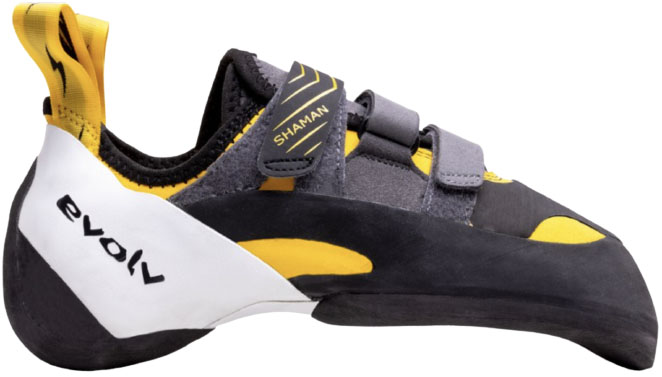 Best uses: Sport, bouldering, gym
Best uses: Sport, bouldering, gym
Downturn: Aggressive
Upper: Synthetic
What we like: A powerful shoe for steep climbing.
What we don’t: Some sport climbers and boulderers will want a softer shoe.
Designed in part by Chris Sharma, the Shaman is best suited to the kind of climbing Sharma enjoys most: steep, endurance limestone sport routes. They perform incredibly well on this terrain, dominating small pockets, toeing in on positive crimps, toe hooking on tufa-like features, and heeling on small edges. The Trax SAS rubber is super sticky and features a Variable Thickness Rand, designed to pattern durability and flexibility throughout the sole. Meanwhile, the synthetic upper maintains a tight fit over time, and the three Velcro straps are thin enough to give ample room for toe rubber.
The Shaman was updated last year and now comes in four separate models: a lace-up (available in high- and low-volume fits) and the Velcro version here (also available in two volumes). Like the outgoing design, all four Shamans still feature Evolv’s unique “Knuckle Box” and “Love Bump” technologies, which keep the foot in a powerful yet comfortable position. And unlike your average Velcro shoe, the Evolv is relatively stiff, akin to the Instinct VS above (that said, the split sole does offer more flexibility than a design like the Katana). Modern boulderers and gym climbers will want a softer design, but the Shaman nevertheless offers top-notch power and precision for edging and hooking up steep climbs.
Read more: Evolv Shaman review (prior version)
See the Evolv Shaman See the Evolv Shaman LV
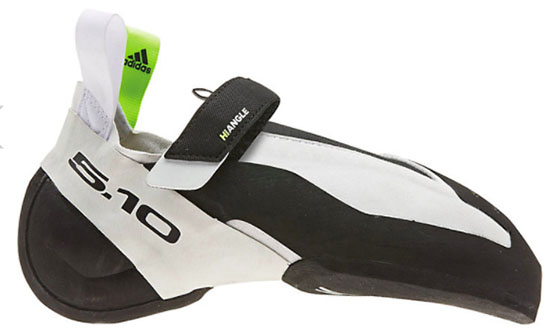 Best uses: Bouldering, sport, gym
Best uses: Bouldering, sport, gym
Downturn: Aggressive
Upper: Synthetic
What we like: Best toe hooker in the business; very comfortable.
What we don’t: Lacks the close fit and comfort of leather; hard to find.
Similar to the Scarpa Instinct VS and La Sportiva Skwama above, you’re likely to see the Five Ten Hiangle on the foot of many a pro boulderer or sport climber. With a huge pad of sticky toe rubber, an aggressive downturned shape with lots of sensitivity, and a Velcro strap to keep the shoe from sliding off on heel hooks, this shoe screams steep climbing. And perhaps the most standout feature is the price: While most of the competition slides in between $190 and $220, Five Ten (aka Adidas) has managed to keep the Hiangle relatively affordable at just $160.
The previous Hiangle had a tendency to stretch out of shape and become floppy over time, but the current version replaces the leather upper with an unlined synthetic microfiber. While the result is a snugger fit throughout the shoe's lifespan, some climbers will still prefer the close fit and comfort of leather (if you can relate, take a look at a partially leather shoe like the Skwama). But the rest of the updated Hiangle is virtually unchanged, and it's still a high-performance offering for serious sport climbers and boulderers—that is, if you can find it. At the time of publishing, stock is very low, which seems to be a recent trend with Five Ten models.
See the Men's Five Ten Hiangle
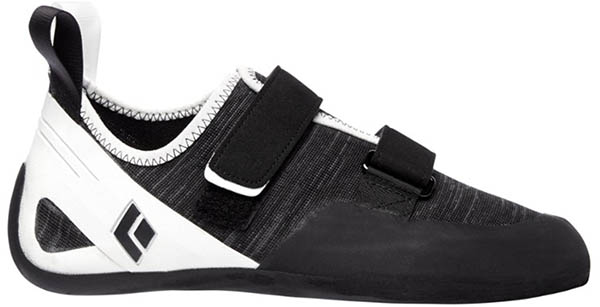 Best use: Beginner
Best use: Beginner
Downturn: Flat
Upper: Synthetic
What we like: Checks a lot of boxes for beginner climbers.
What we don’t: Too narrow for some; not a high-performance shoe.
Black Diamond’s Momentum is purpose-built for new climbers looking for a comfortable shoe that doesn’t break the bank. In fact, it’s one of just a small number of designs still available for $100 or less. With the Momentum, you get a unique stretchy knit upper for ventilation and all-day comfort and high-quality Neo Fuse rubber underfoot. And Black Diamond continues to improve the quality of the shoe, with the most recent iteration featuring a softer lining and toe rand, an improved midsole for better edging, and a retooled fit with more tension from toe to heel. All in all, it’s a solid and very affordable choice for entry-level climbers or those looking for a gym workhorse.
Keep in mind, however, that you get what you pay for here: The tongue flaps on our pair of Momentums have a tendency to bunch up under the Velcro closure, and we’ve found the toe box to be quite narrow. Further, the knit upper gives up a lot in the way of durability and fit, which is especially important if you’re climbing outside. If the Momentum doesn’t seem like the shoe for you, it’s worth checking out Black Diamond’s more performance-oriented offerings. In particular, their trad-focused Aspect and aggressive Method S have become fairly popular throughout their short lifespans. And it’s worth noting that all of BD’s shoes use Butora’s Neo Fuse rubber, which is impressively sticky and durable. But brand allegiance can be strong, and we’ve found little reason to switch over from our beloved Italian-made shoes.
Read more: Black Diamond Momentum review (prior version)
See the Men's Black Diamond Momentum See the Women's Black Diamond Momentum
| Climbing Shoe | Price | Downturn | Upper | Rubber | Best Uses |
|---|---|---|---|---|---|
| La Sportiva Katana Lace | $219 | Moderate | Leather | Vibram XS Edge/Grip 2 | Sport, trad, gym |
| La Sportiva Tarantulace | $89 | Flat | Leather | FriXion RS | Beginner |
| Scarpa Instinct VS | $209 | Moderate | Synthetic | Vibram XS Edge/Grip 2 | Bouldering, sport, gym |
| La Sportiva TC Pro | $219 | Flat | Leather | Vibram XS Edge | Trad |
| Scarpa Drago | $219 | Aggressive | Leather/synthetic | Vibram XS Grip 2 | Gym, bouldering, sport |
| La Sportiva Otaki | $209 | Moderate | Leather/synthetic | Vibram XS Edge/Grip 2 | Sport, trad |
| Scarpa Vapor V | $199 | Moderate | Leather/synthetic | Vibram XS Edge | Trad, sport, beginner |
| Butora Endeavor | $120 | Flat | Synthetic | Neo Fuse | Beginner, gym, trad |
| La Sportiva Skwama | $199 | Aggressive | Leather/synthetic | Vibram XS Grip 2 | Bouldering, sport, gym |
| Evolv Rave | $139 | Flat | Leather | Trax SAS | Trad, gym |
| La Sportiva Mythos Eco | $159 | Flat | Leather | Vibram XS Edge | Beginner, trad |
| Unparallel Sirius Lace | $176 | Aggressive | Synthetic | Unparallel RS | Sport, bouldering |
| La Sportiva Solution | $199 | Aggressive | Leather/synthetic | Vibram XS Grip 2 | Sport, bouldering, gym |
| Scarpa Veloce | $175 | Moderate | Synthetic | S-72 | Gym, beginner |
| La Sportiva Mandala | $209 | Aggressive | Synthetic | Vibram XS Grip 2 | Sport, bouldering, gym |
| Evolv Shaman | $199 | Aggressive | Synthetic | Trax SAS | Sport, bouldering, gym |
| Five Ten Hiangle | $160 | Aggressive | Synthetic | Stealth C4 | Bouldering, sport, gym |
| BD Momentum | $100 | Flat | Synthetic | Neo Fuse | Beginner |
From endless granite splitters in Yosemite to juggy overhangs on bullet sandstone in the Southeast, the Switchback Travel team has smeared, heel-hooked, and edged on just about every type of rock imaginable. Over eight years of meticulous testing, we've laced up countless shoes on lofty peaks in Patagonia, crumbly and baboon-infested cliffs in East Africa, and majestic walls in Nepal to narrow in on our list of 18 models above. Streamlined ballet shoes for delicate boulders or clunky big-wall workhorses—there's an option here for just about every climber.
Former senior editor Jenny Abegg published this guide back in 2016, compiling an initial lineup of 10 worthy picks. An avid alpinist and all-around mountain athlete, Jenny took countless shoes on just as many climbing trips, from international epics to local jaunts up peaks in the Pacific Northwest. Current senior editor Chris Carter inherited the guide in early 2024. Chris is heavily involved in developing and bolting climbing areas around his current home in the sandstone paradise of Chattanooga, Tennessee, and his childhood home in Kenya, East Africa. He has climbed all over the world and tested a wide array of shoe designs on multiple ascents of El Capitan, long multi-pitch romps during international expeditions, and endless lazy days at local crags. Rest assured—no stone was left unturned in our hunt for the absolute best climbing shoes on the market.

There are as many styles of climbing shoes as there are rocks, and for best performance, these two factors should be matched appropriately. Sport climbing, bouldering, and trad climbing tend to be as similar as apples, oranges, and bananas—which is to say, rather dissimilar. A shoe designed for overhanging boulders would be painful and less than functional in a hand crack. In the same vein, a stiff, flat shoe perfect for slab climbing would be clunky and useless when trying to toe hook on steep terrain. That said, whether you’re on a boulder, placing gear, or clipping bolts, the rock will dictate your style of shoe more than the discipline. Granite climbs differently than sandstone, which climbs differently than limestone, quartzite, and basalt, and so on and so forth.
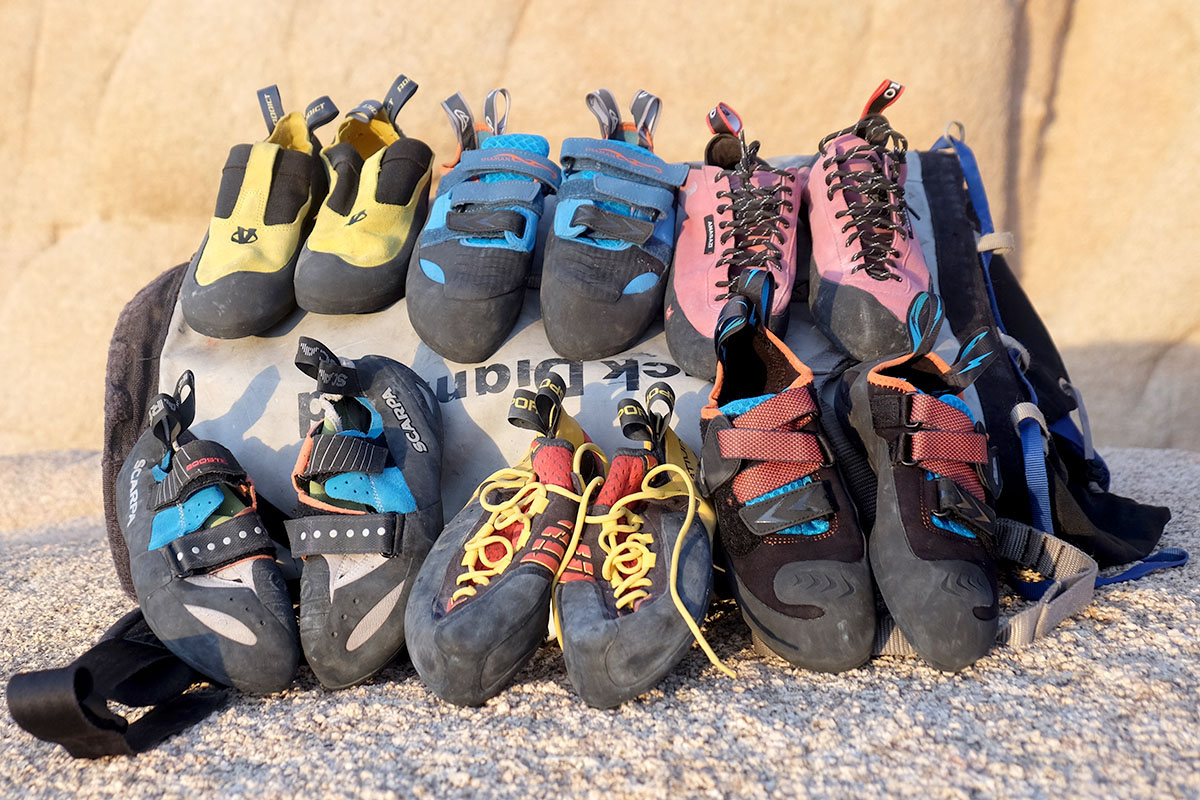
Obviously, there’s no perfect categorization, and a good understanding of the terrain helps to round out these delineations. While the rock type and style of climbing play important roles in narrowing in on the shoe for you, your personal foot shape and how tight you like your shoes will factor in as well. Models with laces allow you to fine-tune the fit more than slip-ons or those with Velcro straps. Some may prefer this, while others want the ease and simplicity of ripping their shoes on and off between climbs. We dig into each of these considerations below, so read on for more help in wading through the masses of options.

Trad
Trad climbing typically takes place on slabby to just-vertical terrain and often involves a great deal of jamming your feet in cracks. For this, flat climbing shoes—also thought of as all-around shoes or non-aggressive shoes—are the top-performing models. These shoes are often more comfortable than their aggressive counterparts, but comfort need not compromise performance. Certain flat shoes offer the best performance for slabs, techy face climbing, and cracks (the La Sportiva TC Pro, for example).

Look for very slight or no downturn at all, a stiff midsole, relaxed fit, minimal heel/toe rubber, solid ankle protection, and most often, laces. That said, the more technical and steep the trad route (think 5.12 finger cracks or thin 5.11 edging on Index granite), the more you might prefer a shoe with a moderate or aggressive downturn. For vertical faces and thin finger cracks, a model like the La Sportiva Katana Lace will perform far better than the clunky TC Pro.

Trad shoes also tend to be worn on longer multi-pitch climbs (either bolted or not), and many opt for a slightly looser, more comfortable fit for these climbs, as opposed to those they may wear for shorter sport climbs or bouldering. If you'll be spending multiple hours in a row in your shoes and don't want to have to remove them at each belay, you need them to be cozy. Taking it a step further, big wall climbs like you find in Yosemite often allow you to switch between approach shoes while aid climbing and climbing shoes when pulling free moves. For these types of climbs, you could get away with a tighter-fitting pair of shoes for more precise climbing since you won't be wearing them on each pitch of your climb. In the end, the design and fit of trad shoes you land on will boil down to the type of climbing you plan to do and how long you plan to spend laced up for each climb.

Sport
For sport climbing on vertical to slightly less-than-vertical terrain—imagine Smith Rock or the New River Gorge—you can get away with a relatively stiff shoe with a moderate downturn. These models absolutely shine on face climbs where precision edging is paramount. They’re characterized by a solid edging platform, tight heel cup with a slingshot-style rand, stiff midsole, and laces or a Velcro closure. One of our favorites is the La Sportiva Otaki. For steeper sport climbing (such as that found in Kalymnos, The Red, Chattanooga, or even in the gym), we’d look to a softer and more aggressive shoe like those described in the bouldering section below.

The La Sportiva Skwama is a great example: It’s a soft slipper with Velcro closure, aggressively downturned, and sports a whole lot of rubber on the toe and heel. For many climbers, sport climbing shoes don't need to be as cozy as those worn on long multi-pitch climbs, but on the other hand, don't need to fit as tightly as bouldering shoes. They should be comfortably snug for the relatively short duration of 60- to 100-foot single-pitch sport lines, and most climbers will remove them after each climb.

Bouldering
Bouldering shoes—indoor and outdoor—are characterized by an aggressive downturn, generous patch of toe rubber, floppiness for sensitivity, rounded heel cups covered in rubber, and a hybrid closure (often an elastic slipper with a single Velcro strap). These shoes—the Scarpa Instinct VS, for example—shine on steep terrain when toe hooking, heel hooking, and sticking to tiny incuts on overhanging walls. They usually are sized snug and probably aren’t comfortable to wear for extended periods.

If you’re a new boulderer—especially indoors—we recommend that you save your money and foot ligaments and start with a stiffer and less aggressive shoe like the Scarpa Vapor V or La Sportiva Tarantulace. You can graduate to something softer and more aggressive once your technique improves and your feet get stronger, but for V2 and under (even up to V4 in the gym) an entry-level shoe is more than sufficient (for more on soft vs. stiff shoes, see below).

Gym
If you’re just getting started in the gym, the best piece of advice we can offer is to make sure your shoes are comfortable. If your feet aren’t happy, chances are you won’t have an enjoyable introduction to climbing. Our second recommendation is to save your money and opt for an entry-level (or even used) shoe until you’re sure you’re committed to the sport (we have a full list of options in our round-up of the best climbing shoes for beginners). Finally, you’ll probably appreciate a Velcro closure for the gym, where you’ll likely take your shoes off between boulder problems or while belaying. Models like the Black Diamond Momentum and La Sportiva Tarantulace above are great places to start. For more tips on getting started in the gym, check out our Indoor Climbing 101 article.

On the other hand, if you're really pushing your grade indoors (particularly on boulders), you’ll want to be wearing an aggressive, bouldering-specific shoe. Look for soft rubber (Vibram XS Grip 2 is one of our favorites), an aggressive, slipper-like build, and a flexible rand—and be sure to size your shoe relatively tight. Models like the Scarpa Drago and Five Ten Hiangle are great gym options. Further, because of the rise in popularity of indoor comp climbing, climbing shoe companies are now offering even softer versions of their most aggressive shoes—like the La Sportiva Solution Comp and the Butora Acro Comp—designed specifically for indoor climbing. In the end, whether you're new to climbing or projecting double-digit V-grades in the gym, check out the “Best Uses” column of our comparison table above to see which shoes we recommend for indoor climbing.

We have used the term “downturn” many times above—it’s one of the most notable features of a climbing shoe. Essentially, downturn defines the amount of curve in the sole of a shoe, from banana-shaped (aggressive) to flat. The more aggressive the downturn, the more power your toes have to pull and perch on small edges, but the less your feet are able to rest in their natural position. In general, aggressive shoes perform well on steep rock, and flat shoes shine on vertical to less-than-vertical terrain. Just picture the banana shape of a shoe like the La Sportiva Solution, and envision toeing in on overhanging holds with the power to pull your body towards them. Then tilt the rock back to slab, and you’ll understand that you want a flat shoe (like the Butora Endeavor or TC Pro) that allows you to stand on the ball of your foot.
.jpg)
Stiffness is another way that shoes differ from each other, but here it’s tough to make blanket statements. So much of this depends on preference. While many boulderers prefer ultra-soft shoes like the La Sportiva Solution or even Solution Comp, others prefer stiffer models like the Butora Acro or Scarpa Instinct VS. Same goes for trad climbers—the TC Pro is wildly popular, but so are slippers like the Evolv Rave. One thing that we can say definitively is that a stiff shoe offers more support for the foot—if you’re just getting into the sport, you’ll definitely want to start with a stiff to medium-stiff shoe until your feet grow stronger. Soft shoes are far more sensitive and flexible, and your feet will have to do much of the work to support themselves.

A stiff shoe will also offer more edging power, as it provides a solid platform for your foot to stand on tiny edges. For this reason, we like a stiffer shoe for vertical faces and slab. Soft shoes, on the other hand, do not provide the stability needed for precise edging, but enable you to toe in better on steep routes. Plus, you’ll be able to feel the holds more underfoot, which many climbers like. Soft shoes are also more comfortable to downsize, so you can really hone in a tight, snug fit. Finally, keep in mind that the thinner the sole, the softer the shoe will be. For example, the Scarpa Instinct VSR’s 2-millimeter sole helps to make it a much softer shoe than its sibling, the Instinct VS (with a 3.5mm sole).

Closure systems should not be overlooked, and in fact, they can be a deciding factor in what shoe is the best match for you. There are no hard-and-fast rules about which is better than the other, and each has its strengths and weaknesses for various forms of climbing. The three main closures are laces, Velcro, and slippers, and more and more we’re seeing Velcro and slippers combined for a best-of-both-worlds closure.

Laces
Laces are a favorite of trad climbers who put their shoes on and keep them on. They’re much better suited in cracks than Velcro, which tends to come undone after repetitive jamming. Laces also allow you to dial in an incredibly precise fit. Whether your feet are wide or narrow, you get more versatility with a lace shoe than any other kind. That said, laces can be a pain if you are putting on and taking off your shoes a lot, and keep in mind that if you often find yourself jamming your feet in cracks, they're likely to wear out over time.

Velcro
Many climbers prefer Velcro closures because they are easy to put on and take off. They’re great for indoor climbing, bouldering, and sport climbing, when you’re often relieving your feet in between problems or pitches. A Velcro closure, however, can get in the way of toe hooking—for steep bouldering, we’d rather have a large patch of rubber on top of our toe than a bulky strap. Furthermore, Velcro can easily come undone during repetitive jamming in cracks. Velcro shoes can also be somewhat limiting in how well they fit and tend to fail quicker than laces.

Slippers
Slippers provide one of the most comfortable, convenient types of closure, and they generally correlate with soft shoes that excel on friction slabs and in cracks. But slippers can stretch over time, and when that happens, there's no way to tighten them up. Interestingly, the workaround to this problem has resulted in a popular and aggressive design for steep climbing and bouldering. Modern slippers like the La Sportiva Skwama and Scarpa Instinct VS add a single Velcro strap near the ankle of the slipper, which offers a very comfortable and secure fit and a large space on the toe for a big rubber patch. Standard slippers are a bit of a dying breed (the updated Evolv Rave is the only one on our list), but this combination of slipper and Velcro will only grow in popularity.

The upper is the part of the shoe that rests along the top and sides of your foot. Most climbing shoes are made out of leather or a synthetic leather substitute. The key difference to note between the two materials is that leather stretches, while synthetic materials generally do not. Thus, to help maintain their structure, many leather shoes also feature synthetic microfiber overlays and/or a liner at the heel or toe (which also boosts comfort and breathability). If a leather shoe lacks either of these features (as is the case with many highly sensitive shoes, like the La Sportiva Theory and Scarpa Drago), expect it to stretch up to a whole size. Thus, its important to pay attention to the materials when you size your shoe: No shoe should feel particularly comfortable when you first try it on, but all-leather, unlined shoes shoes should fit especially tight.
.jpg)
Climbing shoe rubber is an esoteric subject. Should you buy Vibram XS Edge or XS Grip? Stealth HF or Stealth C4? What about proprietary blends like Trax and Science Friction? The rubber is what will actually stick to the rock, so this is incredibly important, right? Yes, but maybe not as important as you think. All rubbers try to find some balance on the sticky-durable continuum. Some, like Science Friction, go hard to the sticky side, while others, like Sportiva’s proprietary FriXion RS, gravitate to the more durable side. Either way can make sense depending on your priorities. In fact, we know many a male climber who wears the women's version of their favorite Sportiva shoe (such as the Otaki or Miura VS), as most are made with a stickier rubber (XS Grip 2) than the men’s version (XS Edge). Just understand that there is a trade-off: The grippier your rubber, the shorter it will last. The longer it lasts, the less sticky it will be.

But because you asked (you did, right?), we do have our preferred brands and models of rubber. A quick check of the comparison table above is a dead giveaway: Vibram and Stealth are our clear favorites. We especially like the consistent performance of the XS Edge and XS Grip from Vibram, along with Five Ten’s Stealth C4. Butora’s Neo Fuse is quickly earning our allegiance as well. And, of course, when you bust through the rubber, it doesn’t mean you have to retire your shoe. Resolers aren't difficult to find these days—Rock and Resole in Boulder, Colorado, is one of the most widely known—and most even give you the option to change the kind of rubber that’s on your shoe.

We could give you a bunch of rules about how to size your shoe, but in the end, sizing is so specific, so unique, and so particular to each shoe and each foot. Some shoes will be too wide or too narrow for your feet. Some will stretch a full size, while others won’t at all. Some are sized on track with street shoes (Black Diamond’s lineup, for example), while others will have you dropping down a handful of sizes. As a result, your best bet is to a.) do some research on what other people have to say about the shoe’s fit and b.) always try the shoe on before buying. If you’re ordering online, you can roll the dice or buy a couple of pairs from a reputable retailer and return one.

That said, a few generalizations apply. First of all, you want your climbing shoes to feel tighter than your street shoes. Second, tighter does not mean cutting off circulation. If you’re swimming in your shoe, it’s probably too loose. But if putting it on takes you a minute of serious tugging only to result in a number 8 on the pain scale, they’re too tight. Be honest with yourself: How tight can you go without letting discomfort get in the way of the joy of climbing? Many people—especially boulderers—will sacrifice pain for the extra performance it brings to their climbing game, while others think that a tight shoe adds very little performance. It all depends on the terrain, the shoe, and the climber. Third, understand that leather stretches and synthetic fabrics tend not to. Finally, it’s worth noting that most people have one foot that’s slightly bigger than the other, so try on both shoes before you make a purchase. And if your feet are egregiously different sizes, go with Evolv: While they no longer offer shoes in split sizes, they will stretch them for free.

Men’s and Women’s Versions
Most climbing shoes are available in both men's and women's versions, with the main differences coming in terms of fit and rubber. In general, men’s shoes have a higher volume fit, while women's shoes are slimmer in both the toebox and heel and are designed for lower-volume feet. Second, it's common to see stiffer (and more durable) rubber-like Vibram XS Edge on men's shoes and softer (and stickier) Vibram XS Grip 2 on women's shoes. As we mentioned above, stiffer rubber is great for edging and slab climbing, while many sport climbers and boulderers prefer softer compounds for better grip and sensitivity.

Climbers can be especially picky about their rubber choices, so it's very common to see men wearing women's shoes and vice versa. In the end, we like to think of a shoe's two models as being Option A and Option B rather than assigning them genders. Butora offers their shoes in “wide” and “tight” rather than in men's and women's versions, and it's also common to see "high-volume" and "low-volume" designations. Finally, keep in mind that some unisex models (like the popular La Sportiva TC Pro) aren’t made in varying widths. If your foot is wider or narrower than most, it’s likely that these shoes won’t work for you.
Our list features some of the best all-around climbing shoes on the market, and many of the models above are used by professional climbers pushing the limits of the sport. The TC Pro was worn by Tommy Caldwell on his free ascent of the Dawn Wall, Alex Puccio regularly boulders in the Scarpa Instinct VS, and Margo Hayes became the first woman to climb 5.15a while wearing the La Sportiva Solution. But they’re not only for the elite: These shoes are ideal models for anyone pushing their own personal limits (just make sure you get the right style for your preferred discipline).
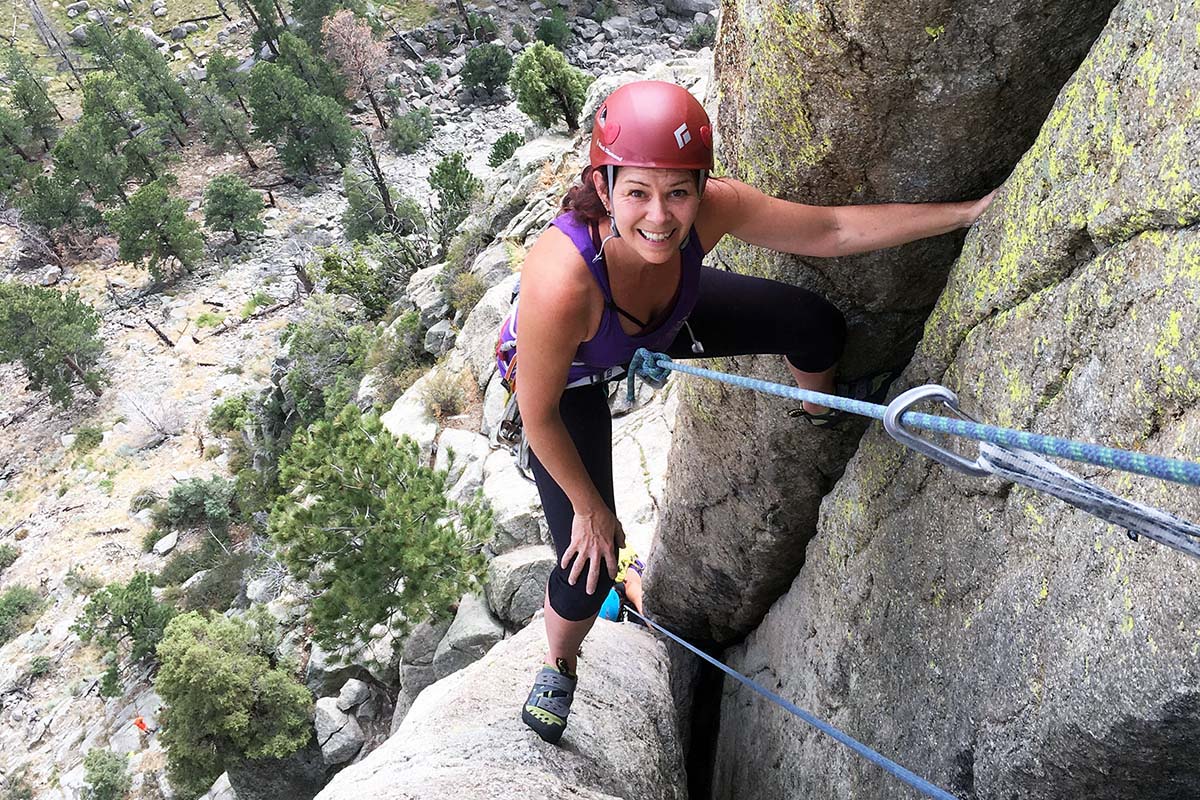
However, for brand-new climbers just starting out, there are a number of reasons why it’s a good idea to opt for a beginner shoe. For one, you don’t even know if you love climbing, so there’s no use spending $200 on shoes when you can get a pair on sale for $50. Second, it’s likely that you’re not yet sure what style of climbing you’re going to gravitate towards, be it gym climbing, bouldering, trad, or sport. And third, all the high-tech and premium materials that go into most of the shoes above will be wasted on poor footwork. In short, most beginner climbers won’t be able to tell the difference between a budget shoe and a high-level model, so it’s your best bet to opt for the cheaper of the two. To help you make your purchase, we’ve compiled a list of the best climbing shoes for beginners, including some of the best models for those who plan to progress quickly. We also have an article to help you choose the best shoes for your preferred style and level.
Back to Our Top Climbing Shoe Picks Back to Our Climbing Shoe Comparison Table